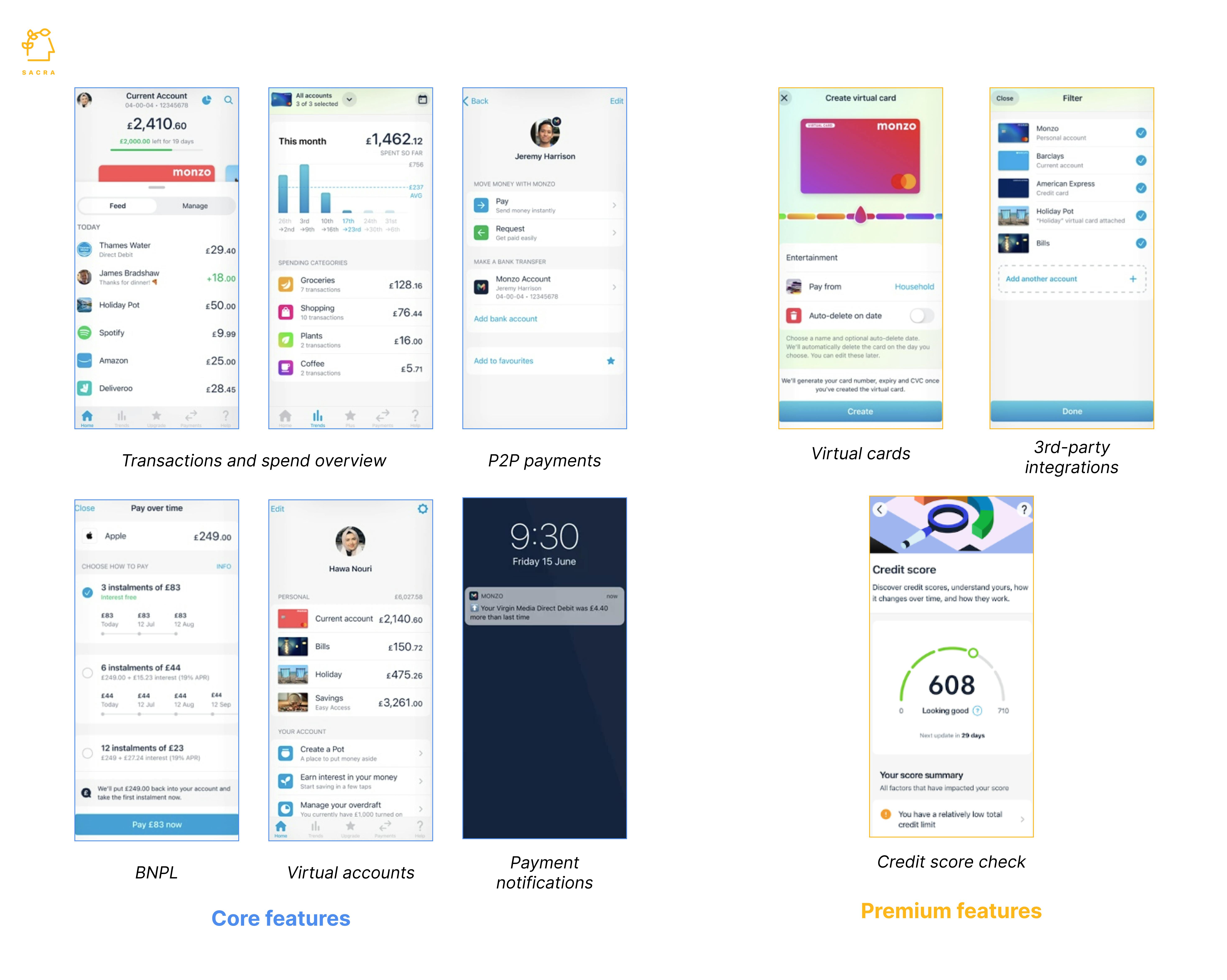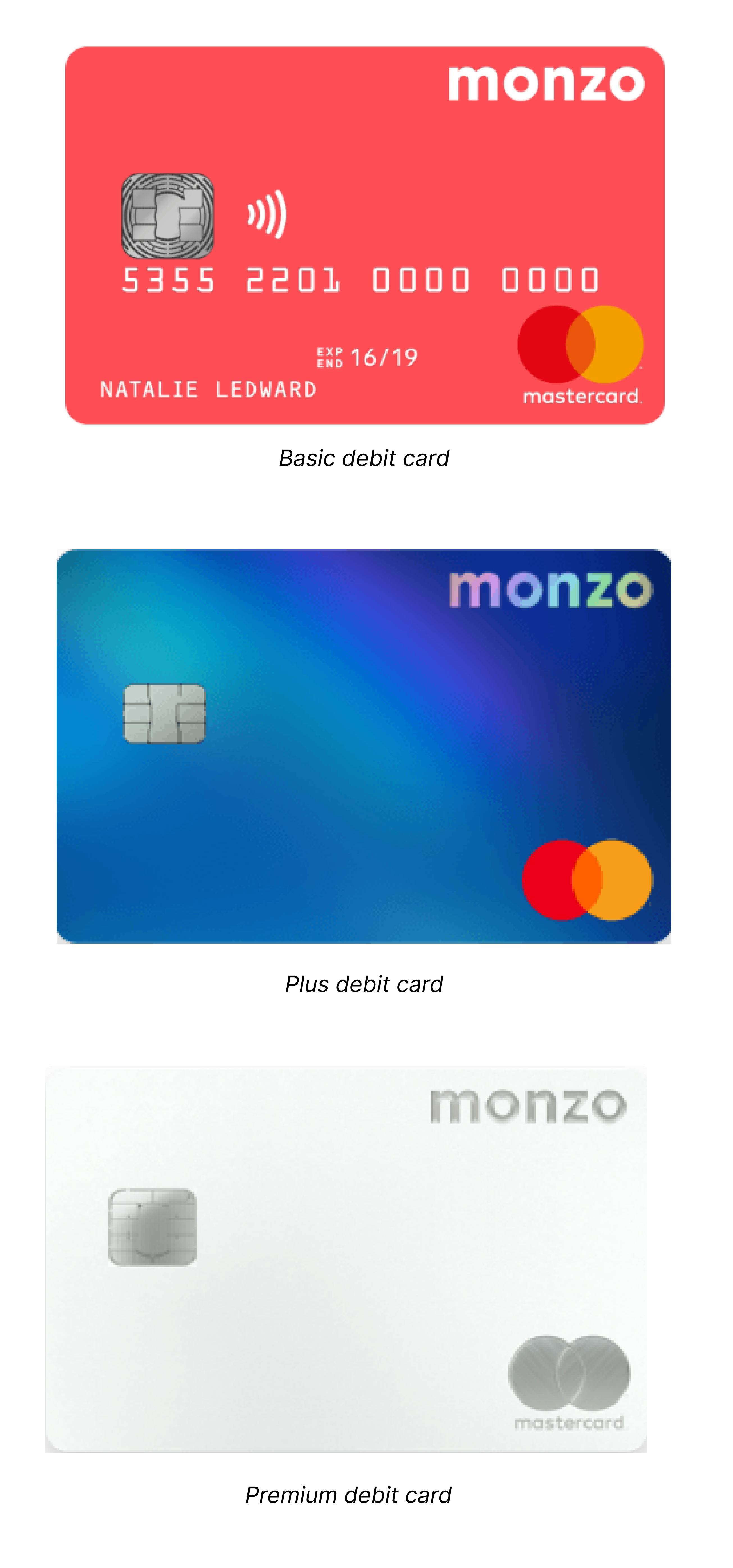
Revenue
$1.67B
2025
Funding
$610.00M
2024
Growth Rate (y/y)
48%
2025
Revenue
Sacra estimates that Monzo generated $1.67B in trailing twelve months (TTM) revenue in the year ending March 31, 2025, up from $1.25B as of the end of 2024.
Total customer deposits grew 48% to $22.4B, while their total number of customers grew 25% from 9.7M to 12.2M.
The company's loan portfolio expanded 35% to $2.2B, reflecting strong growth in their lending business.
Monzo achieved a significant milestone in profitability, with pre-tax profits reaching $81.7M in FY2025, compared to $18.8M in the previous year - marking their second consecutive year of profitability.
Valuation & Funding
Monzo is valued at $5.9B as of an October 2024 secondary sale, with participation from existing investors GIC (Singapore's sovereign wealth fund) and StepStone Group.
The company has raised approximately $1.7B in total funding since its founding in 2015. Key strategic investors include GIC (Singapore's sovereign wealth fund), Google's CapitalG and GV divisions, and Tencent. Recent investments have been led by notable firms including Tencent and HongShan Capital.
Product
Monzo is a mobile-first banking app that provides a full current account through a digital interface. Users can open an account in minutes using selfie verification and photo ID, immediately receiving a virtual debit card and a hot-coral physical Mastercard.
The core product includes real-time spending notifications with merchant logos and detailed transaction categories. Users can create up to 20 savings Pots that ring-fence money for specific goals, including Bills Pots that automatically sweep direct debits and Shared Pots for group savings targets.
Features include Salary Sorter, which automatically splits incoming paychecks across different Pots, and Get Paid Early, which releases salary payments one day ahead of standard clearing windows. The app aggregates external bank accounts through open banking integration, providing a unified view of finances.
Monzo offers three paid subscription tiers: Extra at $3.65 monthly provides advanced budgeting tools and credit insights, Perks at $8.54 monthly adds 3.5% interest on savings plus entertainment benefits like cinema tickets and bakery treats, and Max at $20.74 monthly includes travel and phone insurance with roadside breakdown cover.
The platform offers investments through BlackRock partnerships, with ready-made funds and build-your-own ETF portfolios starting from $1.22. A new pensions product launched in 2025 consolidates old workplace pensions into target-date funds with educational content delivered through short in-app lessons.
Credit products include the Flex card, a hybrid of buy-now-pay-later and traditional credit cards, allowing users to pay in full interest-free, split purchases into three installments, or extend payments up to 24 months.
In October 2025, Monzo launched a built-in tax filing tool for Business accounts, powered by Sage, enabling sole traders and landlords to submit returns directly to HMRC from the app. The feature expands Monzo’s business workflow suite ahead of Making Tax Digital in April 2026 and supports its rapidly growing base of SMB customers. It adds compliance utility alongside expense management, team cards, and tax Pots.


Business model
Monzo operates a B2C digital banking model that monetizes through multiple revenue streams tied to customer financial activity and premium subscriptions. The company generates net interest income by paying customers lower rates on deposits than it earns on loans and investments of those funds.
Interchange fees from debit card transactions provide transaction-based revenue that scales with customer spending volume. The company earns additional fees from credit products including overdrafts, personal loans, and the Flex credit card through interest charges and merchant partnerships.
Subscription revenue comes from tiered monthly plans that unlock premium features, higher interest rates, and insurance products. This creates a predictable recurring revenue base with over 1 million paying subscribers generating roughly $100 million annually in high-margin subscription income.
The business model benefits from rising interest rate environments, which expand net interest margins on the $20.3 billion in customer deposits. Customer acquisition costs are relatively low due to viral growth through referrals and strong brand recognition in the UK market.
Monzo's cost structure includes technology infrastructure, regulatory compliance, customer service, and marketing. The company has achieved positive unit economics with average revenue per customer of $122 annually while maintaining competitive customer acquisition costs through digital-first operations.
The model creates network effects as customers consolidate more financial services within the app, increasing switching costs and lifetime value through cross-selling opportunities across banking, lending, investing, and insurance products.
Competition
Neobank challengers
Revolut represents Monzo's most formidable competitor, having secured a UK banking license in 2024 and serving over 10 million UK users. Revolut's super-app approach spans payments, investing, crypto trading, and international transfers with aggressive pricing on foreign exchange and premium subscription tiers offering up to 5% interest rates.
Starling Bank focuses on reliable core banking operations with four consecutive years of profitability and $871 million in revenue. Their Engine by Starling software-as-a-service arm monetizes core banking technology to third parties, potentially subsidizing competitive pricing in retail banking.
N26 continues expanding across European markets with streamlined digital banking services, though regulatory restrictions have limited their UK presence and geographic expansion ambitions.
Deep-capital incumbents
Chase UK leverages JPMorgan's balance sheet to offer market-leading savings rates of 4.8% to 5.1% and zero-fee credit cards. With over $24.4 billion in deposits and 2 million customers, Chase can sustain pricing pressure that independent neobanks cannot match through cross-subsidization from their US parent.
Traditional banks including HSBC, NatWest, Halifax, and Santander have rebuilt mobile experiences to compete on user interface while leveraging existing customer relationships and branch networks. These incumbents retain advantages in mortgage lending, business banking, and complex financial products.
Specialized fintech players
Atom Bank operates as a cloud-native digital bank focused on mortgages and savings with a $6.5 billion loan book and potential IPO plans. Their specialization in specific product categories creates focused competition in lending markets.
TAM expansion
New products
Monzo is expanding into wealth management and retirement services to capture long-term assets under management beyond traditional deposits. The company launched investment products through BlackRock partnerships and introduced pension consolidation services targeting the $3.7 trillion UK retail investing and pensions market.
Credit product expansion includes multiple lending options from buy-now-pay-later through Flex to traditional personal loans and overdrafts. This positions Monzo to capture approximately 20% of UK buy-now-pay-later originations while competing with high-street credit card issuers for consumer lending market share.
Business banking tools including expense management, team cards, and tax filing integration address the compliance needs of 4.2 million UK sole traders and small businesses facing Making Tax Digital requirements by April 2026.
Customer base expansion
Premium subscription penetration offers significant runway with over 1 million of 12 million customers currently paying for enhanced plans. Each additional percentage point of subscription penetration adds approximately $22 million in high-margin annual revenue.
Family banking products including under-16 accounts and family plan bundles provide low customer acquisition cost expansion into younger demographics while increasing household lifetime value through multi-generational relationships.
Geographic expansion into markets with fewer regulatory barriers than Europe, particularly targeting regions with linguistic and regulatory similarities that reduce market entry complexity and compliance costs.
Geographic expansion
US market re-entry represents the largest TAM expansion opportunity, with Monzo raising $430 million specifically to fund American operations and pursue a fresh banking license. Even capturing 1% of the 240 million US demand deposit account market would equal Monzo's entire UK customer base.
International expansion beyond the US focuses on markets with established regulatory frameworks for digital banking and lower barriers to entry than the complex European Union requirements that have challenged other neobank expansion efforts.
Cross-border financial services including international transfers, multi-currency accounts, and global payment solutions leverage Monzo's technology platform to serve increasingly mobile customer bases across multiple jurisdictions.
Risks
Regulatory pressure: UK financial regulators are increasing scrutiny of neobanks around capital requirements, lending standards, and consumer protection—in July 2025, the FCA fined Monzo £21.1 million for failings in anti‑financial crime controls between 2018 and 2020. Stricter regulations could force Monzo to hold more capital against loans, reduce lending growth, or implement costly compliance measures that pressure profitability and competitive positioning against less-regulated fintech competitors.
Interest rate sensitivity: Monzo's profitability heavily depends on net interest margins from the spread between customer deposit rates and lending returns. A declining interest rate environment would compress these margins and reduce the revenue per customer that has driven recent growth, potentially forcing the company to increase lending risk or reduce deposit rates in ways that hurt customer retention.
Competitive pricing pressure: Well-capitalized competitors like Chase UK can sustain below-market pricing on savings rates and fee-free services through cross-subsidization from parent company profits. This creates a structural disadvantage for independent neobanks that must generate sustainable unit economics from UK operations alone, potentially triggering unsustainable price wars or customer acquisition cost inflation.
News
DISCLAIMERS
This report is for information purposes only and is not to be used or considered as an offer or the solicitation of an offer to sell or to buy or subscribe for securities or other financial instruments. Nothing in this report constitutes investment, legal, accounting or tax advice or a representation that any investment or strategy is suitable or appropriate to your individual circumstances or otherwise constitutes a personal trade recommendation to you.
This research report has been prepared solely by Sacra and should not be considered a product of any person or entity that makes such report available, if any.
Information and opinions presented in the sections of the report were obtained or derived from sources Sacra believes are reliable, but Sacra makes no representation as to their accuracy or completeness. Past performance should not be taken as an indication or guarantee of future performance, and no representation or warranty, express or implied, is made regarding future performance. Information, opinions and estimates contained in this report reflect a determination at its original date of publication by Sacra and are subject to change without notice.
Sacra accepts no liability for loss arising from the use of the material presented in this report, except that this exclusion of liability does not apply to the extent that liability arises under specific statutes or regulations applicable to Sacra. Sacra may have issued, and may in the future issue, other reports that are inconsistent with, and reach different conclusions from, the information presented in this report. Those reports reflect different assumptions, views and analytical methods of the analysts who prepared them and Sacra is under no obligation to ensure that such other reports are brought to the attention of any recipient of this report.
All rights reserved. All material presented in this report, unless specifically indicated otherwise is under copyright to Sacra. Sacra reserves any and all intellectual property rights in the report. All trademarks, service marks and logos used in this report are trademarks or service marks or registered trademarks or service marks of Sacra. Any modification, copying, displaying, distributing, transmitting, publishing, licensing, creating derivative works from, or selling any report is strictly prohibited. None of the material, nor its content, nor any copy of it, may be altered in any way, transmitted to, copied or distributed to any other party, without the prior express written permission of Sacra. Any unauthorized duplication, redistribution or disclosure of this report will result in prosecution.